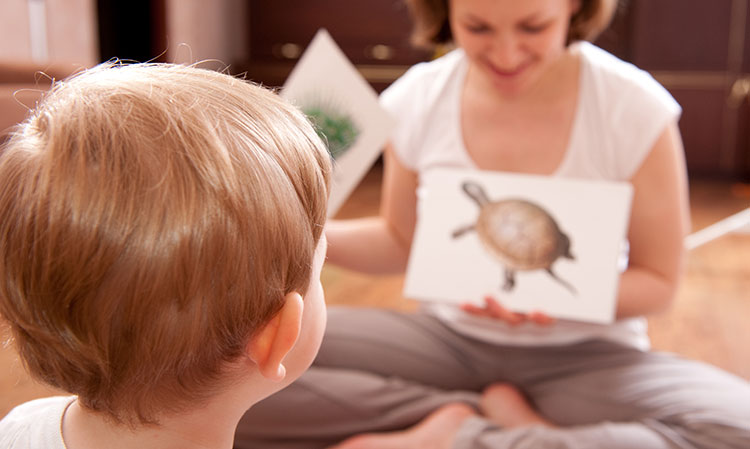E12: Animal Sorting
1. Overview
Sort picture cards by the number of syllables. Your child will get practice listening for the number of syllables in a lot of familiar words.
E12: Animal Sorting
2. Materials & Preparation
- Script
- 4 boxes (shoeboxes or something similar in size)
- animal picture cards (includes word list)
3. Activity
Video: How to play Animal Sorting
Before you start the game, have your child identify the picture on the end of each box, count out the syllables, and figure out how many syllables are in each animal’s name. He can determine this by using his two fingers under his chin to feel the syllables, or he can clap them out.
To start the game, tell your child to pick a picture card from the stack. Tell him the name of the picture, then have him repeat the name and count out the syllables. Once he knows how many syllables there are, he must decide which animal’s box to put it in.
Adult: Okay, pick up a card from the stack. It’s a butterfly! What is it a picture of? Child: A butterfly! Adult: And how many syllables, or parts, are in the word butterfly? Count them out. Child: But – ter – fly … three! Adult: Good. So which animal’s box should you put it in? Child: Um… Adult: You said butterfly has three syllables. Which animal on the boxes has three syllables in its name? Child: Kangaroo! It goes in the kangaroo box. Adult: That’s right. Kangaroo has three syllables, and butterfly has three syllables.↑ Top
4. Confidence Builder
You can give your child a boost by helping him say the words, very clearly and slowly, giving equal weight to every single syllable. Add dots (one for each syllable) to the box labels in addition to the animal pictures. Your child might find it a little easier to count the dots than to count the syllables in each animal’s name, while also counting syllables in the names of the animals on the other picture cards. ↑ Top5. Extension
When your child is very comfortable with the game, encourage him to determine the number of syllables without clapping or even saying the word out loud, just “hearing” the word in his head. This is hard! Once your child has mastered the counting and sorting of shorter words, move on to longer words with up to five syllables (e.g., refrigerator, Tyrannosaurus). There is no need to go beyond five-syllable words. If the child is frustrated by the five-syllable words, stop and move on to the next activity. NOTE: Five syllables are the maximum for children who are not yet in first grade. If he has mastered four-syllable words, it’s appropriate to move on to the next activity. NOTE: If your child is having trouble with words containing more than three syllables, you can modify the material in the next activity (Syllable Softball) and return to its original design at a later time. ↑ Top6. Variation
Use a collection of household objects or toys — e.g., teddy-bear (treat as one 3-syllable word), fork, scissors, sunglasses — instead of the picture cards. Let your child work out some fidgety energy and make a little noise. Instead of sorting cards into boxes, have him count out the syllables by beating a drum or dropping a coin or marble into a jar. ↑ Top7. Small Groups (2-5 children)
Lesson Objective: Using animal picture cards with one to four syllables, children will count the syllables in each animal name and sort the pictures into containers labelled with an animal picture whose name has the same number of syllables as the picture card. GELDS (Georgia Early Learning & Development Standards): CLL6.4e Georgia Standards of Excellence: ELAGSEKRF2.b Common Core State Standards: CCSS.ELA-LITERACY.RF.K.2.B Additional Materials:- hole punch
- yarn or string
Leave a Reply

